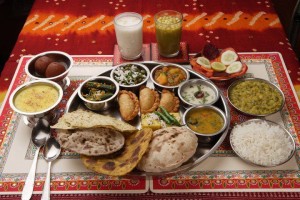
A veggie feast offered with love and devotion to Lord Krishna
The central question about vegetarian diets used to be whether it was healthy to eliminate meat and other animal foods. Now, however, the main question has become whether it is healthier to be a vegetarian than to be a meat eater. The answer to both questions, based on currently available evidence, seems to be yes.- Jane E. Brody
New York Times News Service
Today, with increasing evidence of diet's critical effect on good health and longevity, more and more people are investigating this question: Is the human body better suited to a vegetarian diet or one that includes meat?
In the search for answers, two areas should be considered – the anatomical structure of the human body, and the physical effects of meat consumption.
Since eating begins with the hands and mouth, what can the anatomy of these bodily parts tell us? Human teeth, like those of the herbivorous creatures, are designed for grinding and chewing vegetable matter. Humans lack the sharp front teeth for tearing flesh that are characteristic of carnivores. Meat-eating animals generally swallowtheir food without chewing it and therefore do not require molars or a jaw capable of moving sideways. Also, the human hand, with no sharp claws and with its opposable thumb, is better suited to harvesting fruits and vegetables than to killing prey.
|
|
|
|||||||||||||||||||||||||||||
Digesting Meat
Once within the stomach, meat requires digestive juices high in hydrochloric acid. The stomachs of humans and herbivores produce acid less than one-twentieth the strength of that found in carnivores.
Another crucial difference between the meat-eater and the vegetarian is found in the intestinal tract, where the food is further digested and nutrients are passed into the blood. A piece of meat is just part of a corpse, and its putrefaction creates poisonous wastes within the body. Therefore meat must be quickly eliminated. For this purpose, carnivores possess alimentary canals only three times the length of their bodies. Since man, like other non-flesh-eating animals, has and alimentary canal twelve times his body length, rapidly decaying flesh is retained for a much longer time, producing a number of undesirable toxic effects.
One body organ adversely affected by these toxins is the kidney. This vital organ, which extracts waste from the blood, is strained by the overload of poisons introduced by meat consumption. Even moderate meat-eaters demand three times more work form their kidneys than do vegetarians. The kidneys of a young person may be able to cope with this stress, but as one grows older the risk of kidney disease and failure greatly increases.
Heart Disease
The inability of the human body to deal with excessive animal fats in the diet is another indication of the unnaturalness of meat-eating. Carnivorous animals can metabolize almost unlimited amounts of cholesterol and fats without any adverse effects. In experiments with dogs, up to one half pound of butterfat was added to their daily diet over a period of two years, producing absolutely no change in their serum cholesterol level.
On the other hand, the vegetarian species have a very limited ability to deal with any level of cholesterol or saturated fats beyond the amount required by the body. When over a period of many years an excess is consumed, fatty deposits (plaque) accumulate on the inner walls of the arteries, producing a condition known as arteriosclerosis, hardening of the arteries. Because the plaque deposits constrict the flow of blood to the heart, the potential for heart attacks , strokes, and blood clots is tremendously increased.
As early as 1961, the Journal of the American Medical Association states that ninety-seven percent of heart disease, the cause of more than one half of the deaths in the United States, could be prevented by a vegetarian diet. These findings are supported by an American Heart Association report that states, "In well-documented population studies using standard methods of diet and coronary disease assessment … evidence suggests that a high-saturated-fat diet is an essential factor for a high incidence of coronary heart disease." The National Academy of Sciences also reported recently that the high serum cholesterol level found in most Americans is a major factor in the coronary heart disease "epidemic" in the United States.
Cancer
Further evidence of the unsuitability of the human intestinal tract for digestion of flesh is the relationship established by numerous studies, between colon cancer and meat-eating.One reason for the incidence of cancer is the high-fat, low-fiber content of the meat-centered diet. This results in a slow transit time through the colon, allowing toxic wastes to do their damage. States Dr. Sharon Fleming of the department of Nutritional Sciences at the University of California at Berkeley, "Dietary fiber appears to aid in reducing … colon and rectal cancer." Moreover, while being digested, meat is known to generate steroid metabolites possessing carcinogenic (cancer-producing) properties.
As research continues, evidence linking meat-eating to other forms of cancer is building up at an alarming rate. The National Academy of Sciences reported in 1983 that "people may be able to prevent many common cancers by eating less fatty meats and more vegetable and grains." And in his Notes on the Causation of Cancer, Rollo Russell writes, "I have found of twenty-five nations eating little or no flesh, none had a high rate."
Some of the most shocking results in cancer research have come from exploration of the effects of nitrosamines. Nitrosamines are formed when secondary amines, prevalent in beer, wine, tea, and tobacco, for example, react with chemical preservatives in meat. The Food and Drug Administration has labeled nitrosamines "one of the most formidable and versatile groups of carcinogens yet discovered, and their role … in the etiology of human cancer has caused growing apprehension among experts." Dr. William Lijinsky of Oak Ridge National Laboratory conducted experiments in which nitrosamines were fed to test animals. Within six months he found malignant tumors in one hundred percent of the animals."The cancers," he said, "are all over the place; in the brain, lungs, pancreas, stomach, liver, adrenals, and intestines. The animals are a bloody mess."
Dangerous Chemicals in Meat
Numerous other potentially hazardous chemicals, of which consumers are generally unaware, are present in meat and meat products. In their book Poisons in Your Body, Gary and Steven Null give us an inside look at the latest gimmicks used in the corporate-owned animal factories. "The animals are kept alive and fattened by the continuous administration of tranquilizers, hormones, antibiotics, and 2,700 other drugs," They write. "The process starts even before birth and continues long after death. Although these drugs will still be present in the meat when you eat it, the law does not require that they be listed on the package."
One of these chemicals is diethylstilbestrol (DES), a growth hormone that has been used in the U.S. for the last twenty years despite studies that have shown it to be carcinogenic. Banned as a serious health hazard in thirty-two countries, it continues to be used by the U.S. meat industry, possibly because the FDA estimates it saves meat producers more than $500 million annually.
Another popular growth stimulant is arsenic. In 1972 this well-known poison was found by the U.S. Department of Agriculture (USDA) to exceed the legal limit in fifteen percent of the nation's poultry.
Sodium nitrate and sodium nitrite, chemicals used as preservatives to slow down putrefaction in cured meat and meat products, including ham, bacon, bologna, salami, frankfurters, and fish, also endanger health. These chemicals give meat its bright-red appearance by reacting with pigments in the blood and muscle. Without them, the natural gray-brown color of dead meat would turn off many prospective consumers.
Unfortunately, these chemicals do not distinguish between the blood of a corpse and the blood of a living human, and many persons accidentally subjected to excessive amount have died of poising. Even smaller quantities can prove hazardous, especially for young children or babies, and therefore the United Nations' joint FAO/WHO Expert Committee of Food Additives warned, "Nitrate should on no account be added to baby food." A.J. Lehman of the FDA pointed out that "only a small margin of safety exists between the amount of nitrate that is safe and that which may be dangerous."
Because of the filthy, overcrowded conditions forced upon animals by the livestock industry, vast amounts of antibiotics must be used. But such rampant use of antibiotics naturally creates antibiotic-resistant bacteria that are passed on to those who eat the meat. The FDA estimates that penicillin and tetracycline save the meat industry $1.9 billion a year, giving them sufficient reason to overlook the potential health hazards.
The trauma of being slaughtered also adds "pain poisons" (such as powerful stimulants) into the meat. These join with uneliminated wastes in the animal's blood, such as urea and uric acid, to further contaminate the flesh the consumers eat.
Diseases in Meat
In addition to dangerous chemicals, meat often carries diseases from the animals themselves. Crammed together in unclean conditions, force-fed, and inhumanely treated, animals destined for slaughter contract many more diseases than they ordinarily would. Meat inspectors attempt to filter out unacceptable meats, but because of pressures from the industry and lack of sufficient time for examination, much of what passes is far less wholesome than the meat purchaser realizes.
A 1972 USDA report lists carcasses that passed inspection after the diseased parts were removed. examples included nearly 100,000 cows with eye cancer and 3,596,302 cases of abscessed liver. The government also permits the sale if chickens with airsacculitis, a pneumonia-like disease that causes pus-laden mucus to collect in the lungs. In order to meet federal standards, the chicken's chest cavities are cleaned out with air-suction guns. But during this process diseased air sacs burst and pus seeps into the meat.
The USDA has even been found to be lax in enforcing its own low standards. In its capacity of overseeing federal regulatory agencies, the U.S General Accounting Office cited the USDA for failure to correct various violations by slaughterhouses. Carcasses contaminated with rodent feces, cockroaches, and rust were found in meat-packing companies such as Swift, Armour, and Carnation. Some inspectors rationalize the laxity, explaining that if regulations were enforced, no meat-packers would remain open for business.
Nutrition Without Meat
Many times the mention of vegetarianism elicits the predictable reaction, "What about protein?" To this the vegetarian might well reply, "What about the elephant? And the bull? And the rhinoceros?" The ideas that meat has a monopoly on protein and that large amounts of protein are required for energy and strength are both myths. While it is being digested, most protein breaks down into its constituent amino acids, which are reconverted and used by the body for growth and tissue replacement. Of these twenty-two amino acids, all but eight can be synthesized by the body itself, and these eight "essential amino acids" exist in abundance in non-flesh foods. Dairy products, grains, beans, and nuts are all concentrated sources of protein. Cheese, peanuts, and lentils, for instance, contain more protein per ounce than hamburger, pork, or porterhouse steak. A study by Dr. Fred Stare of Harvard and Dr. Mervyn Hoarding of Loma Linda University made extensive comparisons between the protein intake of vegetarians and flesh-eaters. They concluded that "each group exceeded twice its requirement for every essential amino acid and surpassed this amount by large margins for most of them."
For many Americans, protein makes up more than twenty percent of their diet, nearly twice the quantity recommended by the World Health Organizations. Although inadequate amounts of protein will cause loss of strength, excess protein cannot be utilized by the body; rather, it is converted into nitrogenous wastes that burden the kidneys. The primary energy source for the body is Carbohydrates. Only as a last resort is the body's protein utilized for energy production. Too much protein intake actually reduces the body's energy capacity. In a series of comparative endurance tests conducted by Dr. Irving Fisher of Yale, vegetarians performed twice as well as meat-eaters. By reducing the non-vegetarians' protein consumption by twenty percent, Dr. Fisher found their efficiency increased by thirty-three percent. Numerous other studies have shown that a proper vegetarian diet provides more nutritional energy than meat. Furthermore, a study by Dr. J. Iotekyo and V. Kipani at Brussels University showed that vegetarians were able to perform physical tests two to three times longer than meat-eaters Before exhaustion and were fully recovered from fatigue in one fifth the time needed by the meat-eaters.
Karma and Reincarnation
In human society, if one kills a man he has to be hanged [or punished]. That is the law of the state. Because of ignorance people do not perceive that there is a complete state controlled by the Supreme Lord. Every living creature is the son of the Supreme Lord, and He does not tolerate even and ant's being killed. One has to pay for it.
Capital punishment is the state's ultimate act of reprisal, and no sacrifice surpasses offering one's life for the sake of others. But although we seemingly attach great value to life, each year in America hundreds of millions of defenseless animals are butchered. This wholesale slaughter of animals is not necessary to prevent us from starving. Moreover, it is economically extravagant and ethically reprehensible. Most seriously, however, animal killing violates the universal law of karma, which is similar to the modern scientific principle of action and reaction.
Scientists clearly understand how the physical law of action and reaction ("for every action there is an equal and opposite reaction") applies to material objects, but most are unaware of the more subtle laws of action and reaction in the realm of consciousness. Nevertheless, we do have a kind of instinctive awareness that somehow we all create our own happiness and distress. This realization dawns upon us when in response to some mishap we reflect, "Well, maybe I had that coming to me."
In fact, we sometimes find people jokingly attributing unfortunate occurrences in their lives to "bad karma." But the law of karma insures that those who cause violence and suffering to other living beings must themselves experience equivalent violence and suffering – immediately or in the future.
Karma, as many in the West now know, is intimately related with the principle of reincarnation. In India's greatest spiritual classic, Bhagavad-gita, Lord Krishna describes the soul as the source of consciousness and the active principle that animates the body of every living being. This vital force, which is of the same spiritual quality in all beings, is distinct from and superior to the matter comprising the temporary material form. At the time of death, the indestructible soul transmigrates into another physical body, just as one changes clothing. All living beings (not just a few select individuals) undergo this process of reincarnation, lifetime after lifetime. The Bhagavad-gita states, "As a person puts on new garments, giving up old ones, similarly, the soul accepts new material bodies, giving up the old and useless ones."

 Posted in
Posted in 







